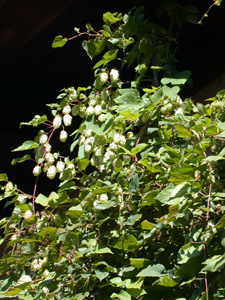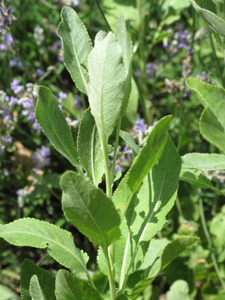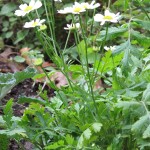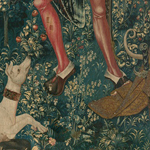Friday, July 8, 2011


Hops (Humulus lupulus), considered today to be crucial to beer brewing, were not commonly used until the fifteenth century. Before that time, brewers added different herbs, such as??alecost??(Tanacetum balsamita), to their beer to improve its flavor. Several of these medieval brewing herbs can be found in Bonnefont garden.
Ale is made of malte and water; and they the which do put any other thynge to ale then is rehersed, except yest, barme, or godesgood, doth sofystical theyr ale.
???Andrew Borde, The fyrst boke of the introduction of knowledge, 1452
Beer was a staple drink for medieval Europeans, as it provided much-needed calories to the often undernourished population and was cleaner and safer to drink than water. Then, as now,??beer was made by brewing malted barley in boiling water to make sugars more available for yeasts to consume (see an image of Jorg Prewmaister tending his brew in a page from a fifteenth-century German manuscript, Amb. 317.2). This sugary, malty potion, known as “wort,” eventually becomes beer after the yeasts eat the sugars, releasing carbon dioxide and alcohol as byproducts of fermentation. On its own, wort is fairly flat in flavor, so brewers add additional ingredients, such as hops and spices, to enliven a beer’s taste.
Read more »
Tags: Achillea millefolium, Add new tag, ale, alecost, barley, beer, brew, bryan_stevenson, costmary, Glechoma hederacea, ground ivy, gruit, hops, humulus lupulus, Ledum palustre, malt, Myrica gale, Reinheitsgebot, stinging nettle, sweet gale, Tanacetum balsamita, Urtica dioica, wild rosemary, wort, yarrow
Posted in Botany for Gardeners, Food and Beverage Plants, Fragrant Plants, Medicinal Plants | Comments (3)
Friday, November 12, 2010
The common name of feverfew is derived from the Latin febrifuge. Botanists now place this member of the aster family in the genus Tanacetum, but feverfew was formerly known both as Chrysanthemum parthenium and Pyrethrum parthenium and may be listed as such in older sources. Above, left and center: Feverfew??growing in Bonnefont garden in November; right: the only feverfew plant depicted in the Unicorn Tapestries appears between the feet of the hunter poised to spear the quarry in The Unicorn Defends Itself.
Feverfew (Tanacetum parthenium) is a strongly aromatic herb in the aster family; it is closely related to costmary (Tanacetum balsamita) and to tansy (Tanacetum officinale), both of which also grow in Bonnefont garden. While tansy has been employed as a medicine, a food, and an insect repellent, feverfew is strictly a medicinal herb. The medieval name of this antipyretic??species is derived from the Latin febrifuge and refers to its usefulness in driving off fever. Read more »
Tags: antipyretic, balsamita, Capitulare de Villis, Centaurium erythraea, centaury, Chrysanthemum, costmary, febrifuge, febrifugiam, feverfew, herb, Herbarius Latinus, Hortulus, Pyrethrum, Tanacetum, Tanacetum officinale, tansy, Unicorn tapestries, Walahfrid Strabo
Posted in Gardening at The Cloisters, Medicinal Plants, Plants in Medieval Art | Comments (0)





